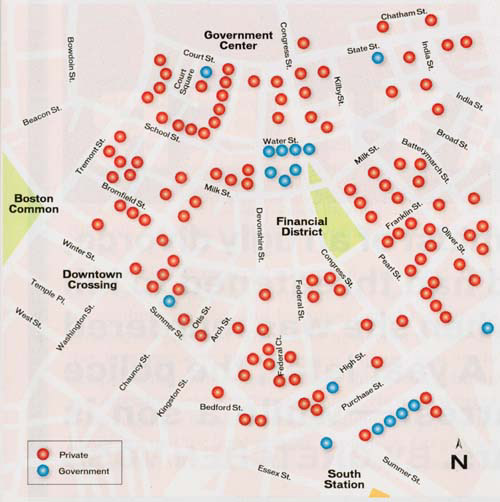

Between 25 and 27 April 2003, two Surveillance Camera Players from New York City (Sean and Bill) traveled to and stayed in Boston, Massachusetts. Brought to the area by the Boston Cyberarts Festival (BCF), the pair spent their first day scouting out and mapping public surveillance cameras in Cambridge (in and around Harvard Square, to be exact). This particular location was chosen because the folks at BCF had scheduled Sean and Bill's walking tour to begin at the Sackler Museum, which is a part of Harvard University.
As the map of Harvard Square indicates, Cambridge has comparatively few surveillance cameras. The pair of mappers could only find 29 cameras in and around the Square (which, as its name suggests, borders Harvard University and is full of Harvard University students): 25 installed on private property (banks mostly), 3 installed on Harvard University property, and 1 installed on a government building.
The very fact that Harvard University uses surveillance cameras to watch the doors and exteriors of its buildings is significant, in that Yale University, by contrast, does not. (Come to think of it, nor does Princeton.) Sean and Bill certainly missed a number of Harvard-operated cameras, not only outside of but also within the area of Cambridge upon which they focused. As a matter of fact, when it came time to give their walking tour, Sean and Bill ended up concentrating on several Harvard-operated cameras that they only just spotted on their way to the meeting point! Two of these previously unspotted -- and still unmapped -- cameras are installed on the Sackler Museum itself.
Almost all of Harvard Square's private cameras or, rather, the cameras operated in the square by private institutions other than Harvard University, are installed in clusters, that is, on single buildings that are surrounded on all four sides by cameras. Though the pair managed to spot the small camera mounted on the Mt Auburn Street headquarters of the Harvard University Police (who ride around in cars), they couldn't find any cameras that looked like they were installed and/or operated by the Cambridge Police Department (who also ride around in cars). They also couldn't find any traffic cameras of any kind (flow monitoring or red-light clicking).
All of this suggests that the only one in Cambridge committed to using cameras to videotape the theft of valuable property (by insiders?) is Harvard. Everyone else -- the average citizen, the police officer and the neighborhood shopkeeper -- is either oblivious to the danger, unperturbed by it, or convinced that video surveillance does nothing to either deter or even detect the crime.
The story is different in neighboring Boston, which Sean and Bill scouted and mapped out (in the rain) the following day, 26 April 2003. Here or, rather, in Boston's Financial District, the pair located a total of 128 surveillance cameras: 110 installed on private property, 10 on government buildings, 6 on highly elevated positions, and 2 on street poles (one of these pole-mounted cameras looks like it is used to monitor automobile traffic, the other like it is used by the Boston Police Department to monitor a particular spot in which it suspects some sort of criminal enterprise is taking place.)
As always, the elevated cameras -- the pair of mappers briefly toyed with calling them snipers -- are of special interest. Not only are these cameras highly elevated, usually sitting atop tall buildings and thus only visible from a distance, but they also typically look horizontally over the city, not down upon parts of it. And so one imagines that they must be operated by TV stations, Web sites, local police departments and/or federal authorities (the Federal Aviation Administration or the FBI). In Boston's case, a few of the snipers are installed on top of the Federal Reserve Bank; all of them are positioned to look out over the infamous "Big Dig," the multi-billion-dollar boondoggle that's transformed downtown Boston into a site perpetually "under construction." And so one could add the Department of the Treasury, the Department of Labor, the Occupational Safety and Health Administration and the Department of Transportation to the list of federal agencies that would be likely to install or demand to get a feed from one or several of Boston's half-dozen elevated cameras.
At 3 pm on Sunday 27 April 2003, Sean and Bill gave their walking tour of Harvard Square for about 20 people. At the end of it, the pair performed God's Eyes Here on Earth at the corner of Holyoke and Massachusetts Avenue, directly beneath one of the many globe-shaped cameras operated by the Consolidated Bank. The following pictures were taken by a tour participant: placard identifying performers as Surveillance Camera Players; pointing up at the camera; Sean prays, while Bill looks up.
As a kind of treat for the hardcore devotees (about six people), Sean and Bill then offered a walking tour of Boston's financial district. This second walking tour visited the elevated cameras at the Big Dig, the two pole-mounted cameras referred to above, and a camera operated by the security guards at the CVS Pharmacy on Washington Street, who use the feed from this camera as the "programming" for the large color TV screen that they've installed inside their store. Evidently designed as a round-about-way of informing people entering the CVS that they are under video surveillance, this arrangement (also) provides a ready-made studio for live closed-circuit TV broadcasts.
At no time were there any problems with hecklers, security guards or police officers.
By e-mail SCP@notbored.org
By snail mail: SCP c/o NOT BORED! POB 1115, Stuyvesant Station, New York City 10009-9998